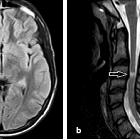Spasmus hemifacialis
Hemifacial spasm is characterized by episodic facial spasms due to irritation of the facial nerve (CN VII).
Clinical presentation
Often the condition begins insidiously with painless spasm of the orbicularis oculi gradually spreading in extent and severity to involve the majority of the face, although often sparing the frontalis muscle. Lifting of the ipsilateral eyebrow with eye closure during the spasm, known as the Babinski-2 sign, is highly specific and sensitive for the condition .
Hemifacial spasm should be distinguished from myokymia a fine undulating fascicular tremor of facial musculature. The two conditions may co-exist.
Pathology
Irritation of the nerve at the root exit zone by an aberrant vascular structure is usually a cause. In one study, up to 100% of cases had a vessel contacting the nerve in symptomatic patients, whereas up to 30% of asymptomatic patients had a similar finding. This is a similar mechanism to what is seen in trigeminal neuralgia, nervus intermedius neuralgia, glossopharyngeal neuralgia, and vagoglossopharyngeal neuralgia.
Most commonly, an elongated and ectatic vertebrobasilar system is commonly seen incidentally. The vessels most commonly implicated, in decreasing order of frequency, are the AICA, PICA and vertebral artery.
Other causes of hemifacial spasm have been reported including:
- vascular compression as discussed above: most common
- cholesteatoma
- schwannoma
- meningioma
- intracranial lipoma
- arteriovenous malformation
- multiple sclerosis: very rarely implicated
Treatment and prognosis
Microvascular decompression is a useful treatment, with up to 80% complete and immediate resolution of symptoms.
Siehe auch:
- Meningeom
- Cholesteatom
- Arteria vertebralis
- Arteriovenöse Malformation
- intrakranielle Lipome
- Schwannom
- Encephalomyelitis disseminata
- Arteria cerebelli inferior posterior (PICA)
- neurovaskuläre Kompressionssyndrome
- myokymia
- Nervus facialis wird von Arteria vertebralis berührt
- Glossopharyngeusneuralgie
und weiter:

 Assoziationen und Differentialdiagnosen zu Spasmus hemifacialis:
Assoziationen und Differentialdiagnosen zu Spasmus hemifacialis:








